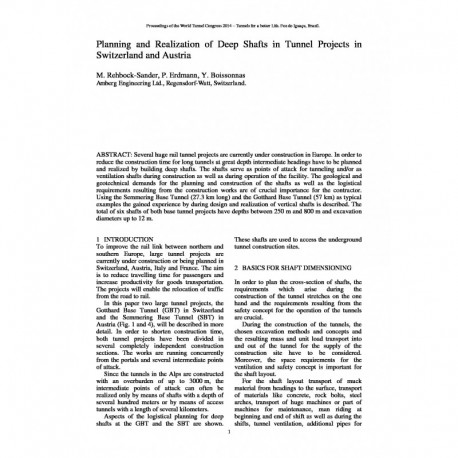Cart
0
0
No document
0,00 €
Total
Document successfully added to your shopping cart
Quantity
Total
There are 0 items in your cart.
There is 1 item in your cart.
Total documents
Total shipping
To be determined
Total
Search & filter
Search for a publication
Search & filter
Planning and Realization of Deep Shafts in Tunnel Projects in Switzerland and Austria
pap374
P. Erdmann / M. Rehbock-Sander / Y. Boissonnas
Several huge rail tunnel projects are currently under construction in Europe. In order to reduce the construction time for long tunnels at great depth intermediate headings have to be planned and realized by building deep shafts. The shafts serve as points of attack for tunneling and/or as ventilation shafts during construction as well as during operation of the facility. The geological and geotechnical demands for the planning and construction of the shafts as well as the logistical requirements resulting from the construction works are of crucial importance for the contractor. Using the Semmering Base Tunnel (27.3 km long) and the Gotthard Base Tunnel (57 km) as typical examples the gained experience by during design and realization of vertical shafts is described. The total of six shafts of both base tunnel projects have depths between 250 m and 800 m and excavation diameters up to 12 m. Especially the hoisting equipment in the shaft and the material handling at the top and foot of the shaft have to be designed in detail and are not very common for tunnel construction. Huge amounts of material have to be handled (up to 21'000 t per day) and heavy and bulky machine parts (i.e. for TBMs) have to be transported through the shaft. This leads to hoisting equipment with transport speed of about 60 km/h and an installed electrical power of 4 MW. The shaft construction can be done either by conventional shaft sinking by Drill and Blast or by using the Raise Drill technology whenever there is an access to the bottom of the shaft. Both technologies of shaft construction have been and will be used at the Gotthard and the




